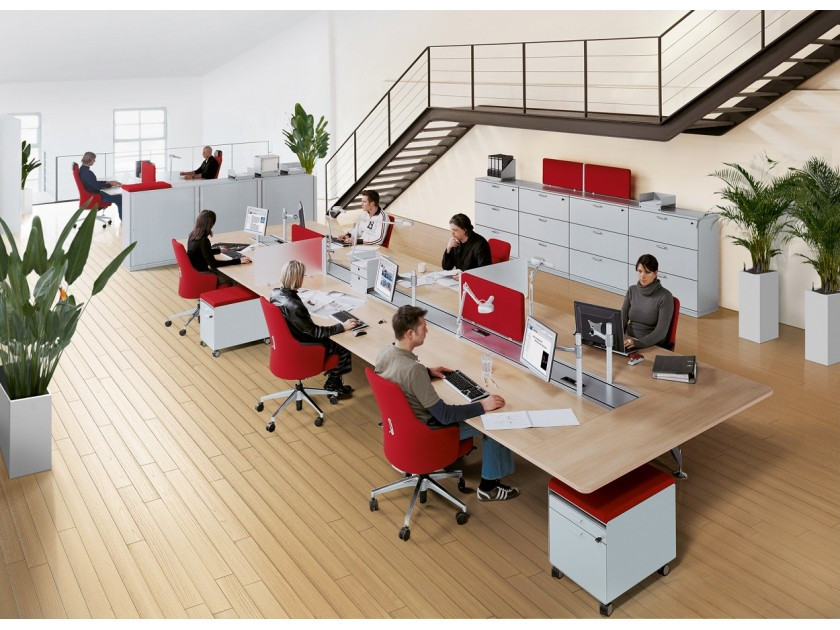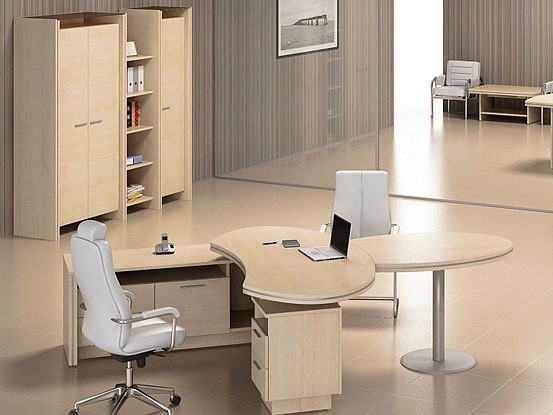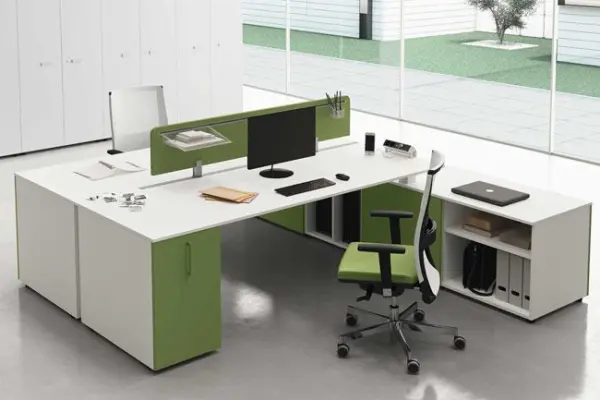A modern office is not just a workplace, but also a mirror of the company's individuality, which makes its design a key aspect of corporate image. Properly selected office furniture becomes the foundation for creating a functional and aesthetically pleasing workspace that enhances productivity and creates a comfortable working environment. Office arrangement requires a comprehensive approach that considers employees' needs and the company's business objectives.
"Office space design is a strategic investment in the company's future. Research shows that a well-organized workplace with ergonomic furniture increases staff productivity by 15-20% and significantly reduces sick days," notes Elena Krylova, a leading specialist in workplace ergonomics. This is confirmed by scientific research published in the Journal of Engineering Management and Competitiveness, which proves the positive impact of office ergonomics on employee productivity.
The Impact of Office Furniture on Productivity and Corporate Culture
Elements of office design directly affect employee work efficiency and corporate culture formation. Modern office interiors should organically combine functionality, comfort, and stylistic unity. The main rule is that each piece of furniture – from workstations to document storage systems – should create a unified harmonious composition.
When planning office space, it is necessary to consider the psychology of color in office interiors, acoustic comfort, and the specifics of organizing various functional zones. Zoning the office space with properly selected furniture allows for creating an effective working atmosphere for both individual work and team collaboration.
| Furniture Characteristic | Impact on Employees | Business Effect |
|---|---|---|
| Ergonomic chairs and desks | Reduced physical discomfort, improved posture | Productivity increase by 15-20%, absenteeism reduction by 67% |
| Modular office solutions | Possibility of workplace personalization | Productivity growth by 32%, increased loyalty |
| Collaboration zones with soft furniture | Improved communication, stress reduction | Faster decision-making, corporate culture development |
| Acoustic partitions and screens | Improved concentration, reduced noise exposure | Error reduction, work quality improvement |
| Eco-friendly office furniture | Improved well-being, reduced allergic reactions | Enhanced company image, compliance with ESG standards |
This table clearly demonstrates that investments in quality office furniture provide measurable returns through increased staff efficiency and strengthened corporate culture.
Employee Workspace Arrangement
 Organizing office space for regular employees requires special attention to ergonomics and functionality. Selecting quality and comfortable office furniture is critically important for ensuring a comfortable working environment. Office desks and chairs should meet ergonomic standards, be durable, and easily adaptable to changes, for example, easy to disassemble and reassemble when moving.
Organizing office space for regular employees requires special attention to ergonomics and functionality. Selecting quality and comfortable office furniture is critically important for ensuring a comfortable working environment. Office desks and chairs should meet ergonomic standards, be durable, and easily adaptable to changes, for example, easy to disassemble and reassemble when moving.
For effective office arrangement, it is necessary to provide:
- Ergonomic workstations with height-adjustable desks
- Comfortable office chairs with lumbar support
- Spacious cabinets and shelving for document storage systems
- Office partitions and screens for zoning open space
- Modular office furniture systems for workspace flexibility
- Meeting room furniture that matches the overall office style
- Specialized furniture for open space considering acoustic properties
Modern workspace design should consider not only functional but also aesthetic aspects. Productivity and office design are closely interrelated, so it's important to properly select office desks and chairs that create a comfortable working environment. Color schemes in office interiors affect employee mood and productivity. To add liveliness to the workspace, it is recommended to use decorative elements that correspond to the modern style of office furniture.
"Employees who are given the opportunity to control and personalize their workspace demonstrate 32% higher productivity. This fact proves that investments in flexible office arrangement solutions quickly pay off through increased staff efficiency," emphasizes Maxim Solovyov, project manager for workspace organization at the consulting company WorkSpace Solutions.
Executive Office: Combining Status and Functionality
 An executive's office should differ from employee workspaces, having a more sophisticated and prestigious appearance. It is important that it harmonizes with the overall style of office furniture and corporate interior design. Furniture for an executive's office should reflect not only individual taste but also the aesthetics of the company's business space, contributing to the creation of a business atmosphere and emphasizing the organization's image.
An executive's office should differ from employee workspaces, having a more sophisticated and prestigious appearance. It is important that it harmonizes with the overall style of office furniture and corporate interior design. Furniture for an executive's office should reflect not only individual taste but also the aesthetics of the company's business space, contributing to the creation of a business atmosphere and emphasizing the organization's image.
When planning an executive's office, consider:
- The need to create a zone for individual work
- Furnishing meeting space
- Selecting materials appropriate to the status (natural wood, leather)
- Providing proper lighting for the workspace
- Creating a storage system that considers document confidentiality
The success of business meetings and negotiations often depends on the comfort and atmosphere in the executive's office. It is important that the design of this space reflects the corporate values and style of the company, creating a favorable impression on partners and clients.
Success Story: IT Company Office Redesign
The company "TechnoMedia," engaged in software development, faced the problem of declining productivity and staff turnover after three years of working in a traditional office with cubicles. Management decided to completely reconsider the organization of the workspace, focusing on ergonomics and hybrid work environments.
The new office design incorporated modern trends in office design: the open space was divided into functional zones using mobile partitions, height-adjustable desks and ergonomic chairs were installed, and comfortable relaxation areas with soft furniture were created. Special attention was paid to acoustic comfort in the office, with sound-absorbing panels installed and isolated "capsules" created for concentrated work or phone calls.
The results were immediate: just three months after the redesign, team productivity increased by 24%, and staff turnover decreased by 31%. Employees noted significant improvements in well-being and increased satisfaction with the working environment. This example clearly demonstrates how properly selected furniture and thoughtful office space planning can transform the working atmosphere and impact key business indicators.
Trends in Office Design and Furniture Selection
.jpg) Modern concepts of office space organization are evolving in accordance with changes in the nature of work and employee needs. According to research published in the Journal of Environmental Psychology, employee comfort and well-being are often higher when working from home, while work productivity is higher in the office - this emphasizes the importance of creating work zones that combine the best qualities of both environments. Transformable office furniture and modular office solutions are becoming increasingly popular, allowing for quick adaptation of space for various tasks.
Modern concepts of office space organization are evolving in accordance with changes in the nature of work and employee needs. According to research published in the Journal of Environmental Psychology, employee comfort and well-being are often higher when working from home, while work productivity is higher in the office - this emphasizes the importance of creating work zones that combine the best qualities of both environments. Transformable office furniture and modular office solutions are becoming increasingly popular, allowing for quick adaptation of space for various tasks.
The architecture of office space today is focused on creating a flexible environment. Open space concepts remain relevant, but they are supplemented by office zoning with furniture to ensure privacy and acoustic comfort. The color scheme in office interiors also plays an important role, which can stimulate creativity or, conversely, promote concentration.
Key trends in office design and furniture selection include:
- Biophilic design with integration of natural elements
- Smart offices with technologically integrated furniture
- Hybrid workspaces for the convenience of remote and office employees
- Eco-friendly office furniture made from recycled materials
- Emphasis on employee well-being when selecting ergonomic furniture
- Furniture for coworking and multifunctional spaces
- Comparison of open and cabinet systems for optimal balance of privacy and communication
- Office furniture styles that reflect corporate values and company brand
When furnishing an office, it is important to consider not only the current needs of the company but also to plan the space considering future growth and possible changes in business processes.
"Poor office design costs businesses dearly. Research shows that unsuccessful workspace organization can cost companies up to 135 billion pounds annually due to reduced productivity. A thoughtful approach to selecting office furniture and planning is not just a question of aesthetics, but a strategic decision affecting financial results," asserts Alexey Morozov, an expert in business process optimization.
Conclusion: Investment in the Company's Future
Furnishing an office with quality and functional furniture is a strategic investment in the company's operational efficiency and employee well-being. Modern office interiors, created with consideration for ergonomics, spatial psychology, and corporate culture, become an important factor in the organization's competitiveness in the battle for talent and productivity improvement.
When planning office space and selecting elements of office design, it is important to adhere to general principles while also considering the specific business and individual needs of the company. Ignoring these principles can be costly both financially and in terms of image.
If you are planning to order office furniture or commission office design, pay attention to experienced corporate furniture suppliers who offer comprehensive office furnishing. Many office furniture manufacturers provide the opportunity to purchase turnkey functional office furniture, which significantly simplifies the process of workspace arrangement. The cost of office furniture varies depending on material quality and design, and with bulk purchases, you can expect corporate discounts on furniture.
Remember that furniture for business centers is not just functional items but tools for creating an effective working environment that affect all aspects of the company's activities from productivity to corporate culture. By investing in quality corporate furniture today, you are laying the foundation for your company's success tomorrow.

